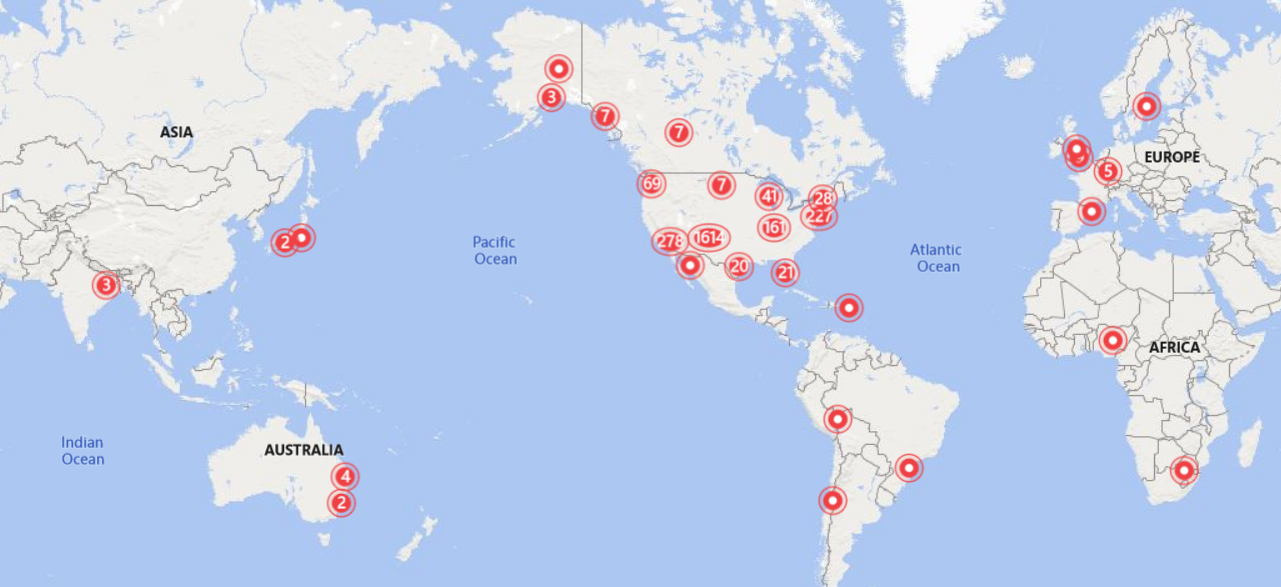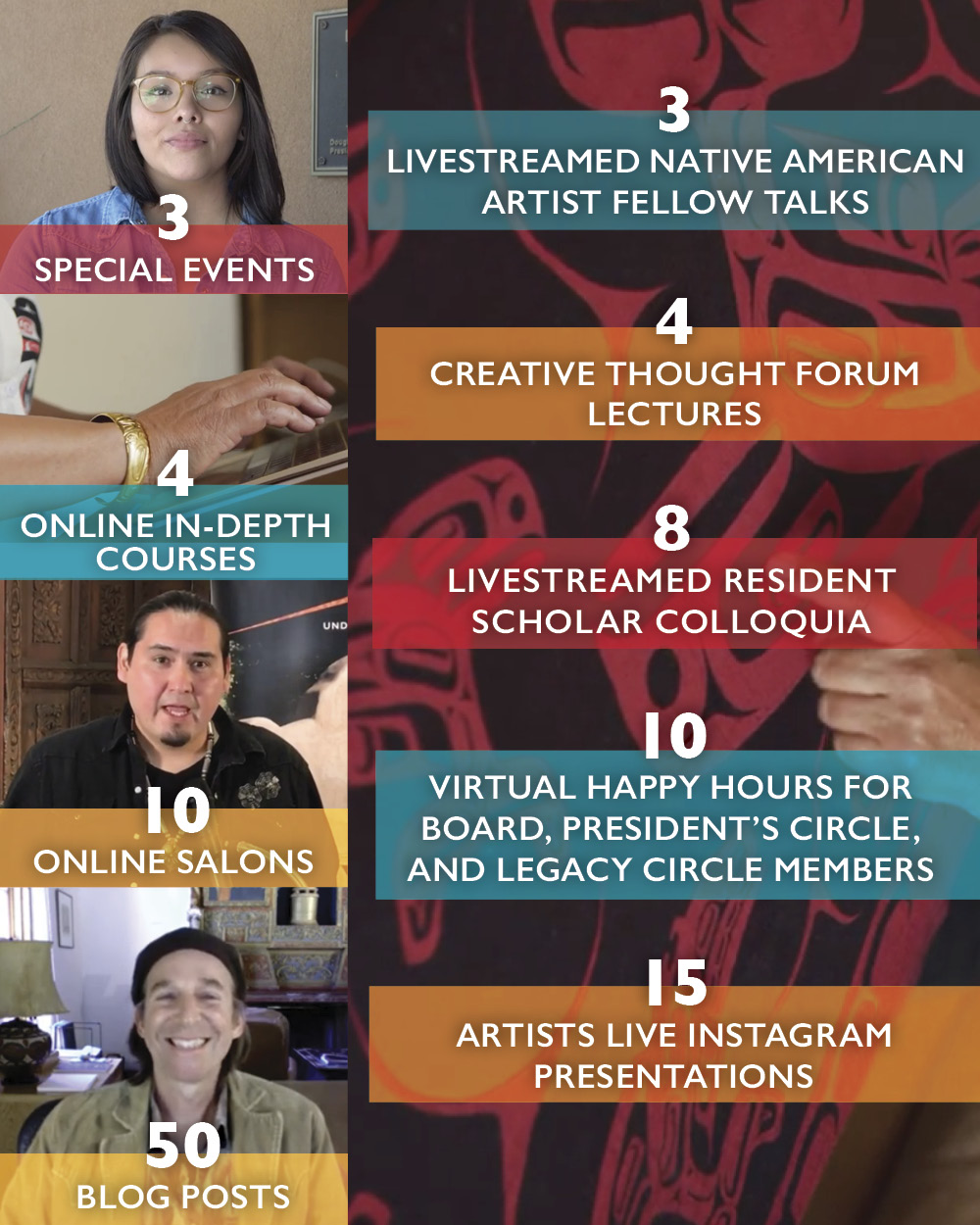Looking Forward, Looking Back

World map showing the locations of individuals who registered for SAR public programs during the 2020 calendar year.
The year 2020, with all of the nation’s social and political turmoil, as well as an ongoing pandemic, revealed how now more than ever the perspectives of social science scholars and Native American artists matter.
In today’s post, we reflect on the last year and invite you to continue joining us for online programs in the new year.
With generous support from SAR’s members and donors, this year SAR was able to launch online projects that expanded the reach of our community to welcome a truly global audience, including:
SAR Impacts—a series of member conversations and profile videos with scholars and Native American artists demonstrating the powerful impact of SAR in the broader community.
Expanded IARC eMuseum—a resource published on our website in late 2019, the online portal has grown to include 1,700 works from the IARC vaults. These include collections from Zuni and Acoma Pueblos with narratives from community members and contributions to the collections from IARC Native artist fellows.
The SAR community grew through events that promoted creative thought. Over 3,000 people from nearly 50 states and over a dozen countries joined us for in-person and online events.
Highlights include

As the pandemic spread across the United States in the spring of 2020, SAR closed its historic campus and IARC collections vaults to the public. Staff began to work from home and public programs transitioned to online platforms. This move to exclusively online programs allowed SAR to welcome a growing global community into conversations with leading experts and to further the mission of advancing creative thought.
In the recent issue of SAR Now (a bi-annual member newsletter) SAR Press director Sarah Soliz reflected on one of these online programs. We are sharing the full piece here.
Join SAR today and you will receive the next print issue of SAR Now directly to your mailbox this spring.
Venturing Virtually into the World of Pueblo Rock Art: Reflections on an SAR Online Salon
On June 30, I joined 173 other viewers for an online presentation by Professor Severin Fowles, SAR’s 2014–2015 Weatherhead fellow. Normally, Dr. Fowles would have spoken to a small group in SAR’s historic boardroom. With the onset of the global pandemic, however, SAR shifted programs to an online format, and in many ways this virtual gathering, like others SAR has hosted this summer and fall, felt like a conversation with one of my graduate school professors. Dr. Fowles discussed the Pueblo rock art of the Rio Grande Gorge and told us, “There’s nothing simple about these images.” As he explained why, I remembered the excitement I felt in my favorite classes: the feeling of diving through the surface of things to swim in the deep waters beyond.
Dr. Fowles described how Native people of the Southwest transitioned from an Archaic to a Pueblo way of life just over a thousand years ago in what was not only an economic but also an aesthetic revolution. People who had foraged for a living began farming and developing what Fowles called the corn lifeway. This revolution was reflected in their rock art. Whereas Archaic rock art of the gorge represented things that were important to hunter-gatherers, like animal tracks, Pueblo rock art represented things that were important to farmers, like the stages of plant growth, and the ideas that went with them. These new images looked like what they represented: birds replaced bird tracks, and humanlike bodies replaced traces of bodies. Instead of a collection of disparate wavy lines, a Pueblo panel might show interconnected elements of a katsina / corn plant / corn mother germinating and putting down roots.
In my favorite example of how much the art changed from Archaic to Pueblo forms, Dr. Fowles described the Droste effect, which is found throughout Western art, as well as in Pueblo rock art. In this tradition, a picture holds another picture that holds another picture and so on until the pictures become too small to reproduce. Together, the layers point beyond the meaning of a single image and send a message about the act of creating images: An Archaic spiral becomes a person holding a shield that holds a star wearing a mask. An image of a toad with bent, upraised arms imitates a human dancing like a raincloud. “Ancestral Pueblo rock art very much took part in its own metapictorial discourse,” argued Dr. Fowles. Early Pueblo people used rock art to “develop a new set of understandings about what images are and how they function.” They used images to tell complicated stories about the corn lifeway and to reflect on those stories and that life.
Whether we’re on the Internet looking at a picture of an artist holding their artwork or in front of a rock looking at a picture of a warrior holding their shield, we see layers of meaning. At its best, school was a place where our teachers taught us how to see these layers and how to find our way through them. Now I’m glad to have access in these virtual programs to the scholars and speakers at SAR, who remind me how much lies beneath the surface of what we see and how important it is to keep exploring those deep waters.
“It is hard to predict what 2021 will bring, but as we head into the new year, we invite you to join us for exciting new programs exploring topics of social concern. This spring, through our Creative Thought Forum, we have developed a series of presentations and live Q&A sessions with leading experts who will address the theme, ‘Facts and Fraud in a Digital Age.’ Our other programs will share new perspectives on the history of our region, on Native American arts and culture, and on a range of topics in anthropology and other social sciences. From in-depth courses to live conversations, all hosted online, 2021 at SAR promises to be a source for intellectually engaging dialogues that anyone is welcome to join, even as we continue to participate from our home offices and living rooms.”
—Michael F. Brown, President, School for Advanced Research
